Abstract
For the near-infrared emission, Er3+ and Er3+/Yb3+ co-activated borate based glass hosts were synthesized by the method of melting andquenching. The emission intensity was maximum for 0.5 mol% Er3+ singly activated glass in the near-infrared (NIR) region covering the telecommunication window. The 2 mol% of Yb3+ co-doping enhanced the emission gain cross-section of the glass by two times contrast to 0.5 mol% Er3+ loaded glass. This enhancement shifted to lower spectral regions when P increased from 0 to 1. The effect of Yb3+ loading on the gain cross-section of the Er3+ co-activated glasses was analyzed using the McCumber theory. The results showed that the 0.5Er2Yb glass has a flat gain in the range of 1460–1640 nm, this suggest a lower pump threshold is enough to perform the laser functioning of a 1530 nm band and optical window of telecommunication applications.
1. Introduction
In the recent past, investigations on ionized rare earth (RE) ions incorporating glassy materials have received significant research interest, owing to their down-conversion and up-conversion (UC) features in infrared and infrared to visible spectral regions, which make them greatly utilized in optical amplifier, high-density optical storage, infrared converters, fiber optic communication and 3D display devices [1]. For decades, the preparation, characterization and property evaluation of REs, such as Nd3+ and Er3+ doped phosphate, borate and silicate glasses have been continued for optical gain medium application of solid-state and fiber near infra-red (NIR) lasers at 1064 and 1530 nm wavelengths [2]. These NIR lasers have been used as NIR light sources for medical as well as sensor equipment, such as LIDAR [3,4].
In particular, the trivalent erbium (Er3+) doped vitreous systems have received tremendous interest because of the photoluminescence (PL) emission at 1530 nm with the considerable emission cross-section and relatively long metastable time. Therefore, these Er3+ activated glasses are found to be best suitable in wavelength division multiplexing (WDM) systems, microchip lasers, fiber amplifiers (EDFAs), lidar transmitters, eye-safe laser systems and waveguides [5]. In addition, the tri-valent erbium ions display luminescence in red, green and blue in the visible regions of the electromagnetic spectrum. The NIR emission intensity and related parameters of the luminescence transitions of Er3+ can be improved through the enhancement of corresponding transition probability, which is dependent on the surrounding ligand field of RE ions [6] for the effective utilization in the aforementioned applications. Further, because of the rapid growth in information technology, flexible networks are very much needed. To this end, the Er3+ doped glasses are of significant interest since the glasses can be molded into any flexible shape and size along with enhanced PL properties [6]. Furthermore, to be specific, the borate-based vitreous materials or glasses are important, owing to their wide range transparency, less processing temperatures, great thermal withstanding and excellent solubility of RE ions (reported up to 20 mol% of solubility in aluminoborate glasses [7]) compared to silicate and phosphate glasses [6]. Nonetheless, the NIR emission efficiency is highly impacted by the glass host, i.e., the energy of the phonons present in the glasses [5]. The addition of heavy metal oxides, such as PbO, Sb2O3, Bi2O3, GeO2, etc., resulted in the decrease of energy of the phonons of the glass network, thereby causing a reduction in the non-radiative relaxation rates, which this change leads to the NIR emission mechanism with ease [8]. In general, a high absorption cross-section of the absorption peaks leads to higher luminescence from the RE ion.
The weak absorption of Er3+ ions in near-infrared region hinders practical use in the large bandwidth NIR device fabrications. The tri-valent ytterbium ions (Yb3+) possess strong absorption in NIR region compared to the Er3+ ion. Hence, it is predicted as a sensitizer that highly improves the efficiency of the down-conversion process of Er3+ ions by energy transfer [9]. In the open literature, there are many investigations revealing the energy transfer mechanisms of Er3+ co-doped Yb3+ diverse glasses, for example [5,6,10,11,12]. Precisely, therefore, there are many attempts at improving the NIR emission of around 1500 nm by co-doping with Yb3+ ions in different glass hosts [8,9,11,13]. In view of this, heavy metal borate glass can play a significant role due to its chemical, thermal and structural versatility [14]. These glasses can be prepared at a low melting temperature and it offers a high refractive index, which minimizes phonon energy and the dispersion of light in the NIR region and offer excellent moisture resistance [15]. However, there are very few reports available on improving the NIR emission efficiency of Er3+ ions by co-doping of Yb3+ ions in borate-based glasses, particularly heavy metal borate glasses.
2. Experimental and Characterization
The glass batches prepared by melt-quenching method for the present work are mentioned below:
Batch 1: 15ZnO − 10Bi2O3 − (75 − x)B2O3 − xEr2O3 (where x = 0.1, 0.5, 1 and 2 mol%)
Batch 2: 15ZnO − 10Bi2O3 − (75 − x − y)B2O3 − xEr2O3 − yYb2O3 (where y = 0.5, 1, and 2 mol%).
For the preparation of Er2O3 (0.1, 0.5, 1 and 2 mol%) and Yb2O3 (0.5, 1 and 2 mol%) co-doped into 0.5 mol% Er3+ doped glasses, the molar percentage of the analytical grade oxides were weighed according to the glass batch formula mentioned above. Using agate mortar and pestle, samples were well-grounded for 30 min to homogenize the oxide mixture. Then, after, the glass mixture was transferred into a porcelain crucible and was placed inside the electrically heated muffle furnace. Initially, the furnace was set to 400 °C and then slowly raised to 1000 °C. For 1 h, the glass batch was heat soaked at 1000 °C inside the furnace to obtain bubble-free molten liquid. Then, after 2 h of melting, the liquid glass batch was quenched on pre-annealed brass mold to obtain bulk glass pieces. These glasses were then heat treated at 273 °C for 3 h and slowly cooled to standard temperature.. Later, these bulk glasses were polished to get 2 mm thicknesses and were labeled as 0.1Er, 0.5Er, 1.0Er, and 2.0Er for 0.1, 0.5, 1 and 2 mol% Er2O3 singly loaded glasses, and co-activated glasses were labeled as 0.5Er0.5Yb, 0.5Er1.0Yb, 0.5Er2.0Yb for Er3+: 0.5 mol % and Yb3+: 0, 0.5, 1.0, and 2.0 mol% loaded in borate based glasses, respectively. The well-polished glasses were used for optical measurements, such as absorption, photoluminescence and decay curves. All physical parameters, are presented in Table 1. The powder form of the same glasses was used for structural characterization, such as XRD and FT-IR using an X-ray diffractometer with a 2θ range 5° to 80° and FT-IR spectra were measured from 4000 to 400 cm−1. The absorption, photoluminescence and decay curves were collected utilizing a Perkin Elmer make Lambda-750 S spectrophotometer.

Table 1.
The physical parameters of Er3+ singly loaded studied glasses.
3. Results and Discussion
The XRD profiles of Er3+ singly loaded glasses are shown in Figure 1. The XRD profiles of the glasses showed broad humps without any sharp crystallographic peaks. The absence of such crystallographic peaks insisted that the prepared glass samples possess an amorphous network in them [16].
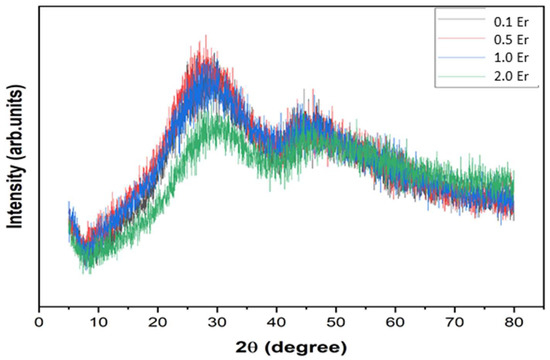
Figure 1.
XRD of Er2O3 doped ZBB glasses.
The features of the FT-IR absorption spectra of the Er2O3 doped 15ZnO, 10Bi2O3, (75 − x)B2O3, and xEr2O3 were recorded with the resolution of 4 cm−1. The powdered form of the samples was palletized using KBr as a binder and, then, it was used to measure the absorption mode of the FT-IR spectra in the infrared region, from 400 to 4000 cm−1. Figure 2 consists of absorption broad bands of the vitreous network of Er3+ doped glasses. The demonstrated band in the spectra, around 441 to 579 cm−1, was attributable to the formation of the octahedral BiO6 group in the vitreous network [17,18]. Additionally, the formation of the BO3 groups in the borate structure absorbed the energy for its in-plane bending vibrations at the same wavenumber, 441 to 579 cm−1 [19]. The broad FT-IR band ranging from 638 to 746 cm−1 is manifested to bending motion of B–O bonds exist in the BO3 units [19]. The FT-IR signature between 787–1046 cm−1, is caused because of the motion of B–O bonds’ in the BO4 motifs [20]. The partial portion of the fourth FT-IR band, from 1144 to 1286 cm−1, has owed to the B–O bond’s stretch in the (BO3)3− functional groups [20]. The other half of the band is in the range of 1301 to 1478 cm−1 because of the stretch of B–O bonds of (BO3)3− groups, which are an integral part of the synthesized vitreous glass network [20]. The structure of bismuth zinc borate glasses has not been modified due to the addition of Er3+ concentration.
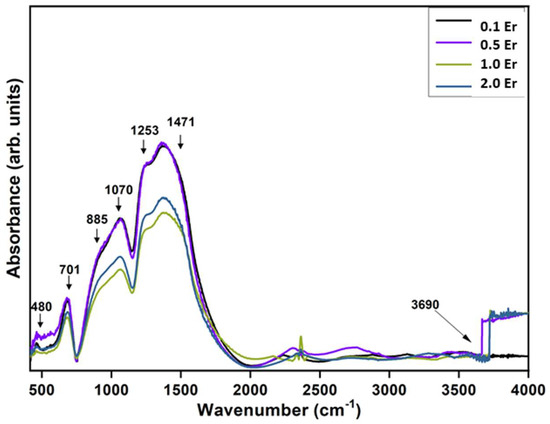
Figure 2.
FT-IR spectral results of studied Er2O3 doped ZBB glasses.
Linear absorption spectral results of Er3+ singly activated glasses depicted in Figure 3 for UV-visible region (upper figure) and NIR region (below figure). The Er3+ ions showed their electronic transitions from their lower energy level (4I15/2) to the different higher energy levels. All the peaks observed for the singly Er3+ doped glass samples used in the current study are assigned by referring to the reference [21]. From the spectra, it can be seen that, the intensity of the bands is enhanced monotonously with respect to Er3+ content in the composition. Among all transitions, the 4I15/2 → 2H11/2 possess highest intensity and is hypersensitive transition [HST], whose intensity sensitive to the surrounding structure [22]. Figure 4 displays the optical absorption spectra of 0.5Er (single) and co-doped (Er/Yb) in UV-vis–NIR (350–1700 nm) regions. Figure 4 shows the additional intense absorption band at 977 nm and it was ascribed to the Yb3+: 2F7/2 → 2F5/2 transition in all co-doped glasses [23,24,25]. Absorption at 977 nm (2F7/2 → 2F5/2) significantly increased with the increment of Yb3+ ions from 0.5 to 2.0 mol% in the Er/Yb multiple RE ions doped glasses. Interestingly, the spectra revealed the broader absorption band around 880 to 1070 nm due to the overlap in the Yb3+ ions 2F7/2 → 2F5/2 transition with the Er3+ ions 4I15/2 → 4I11/2 transition. This specifies the potential of absorption efficiencies in the NIR region than the singly Er3+ doped glass under NIR excitation (λexc = 980 nm). The presence of co-dopant Yb3+ in the glass network increased the NIR, and the demonstrated broad bands are due to light absorption glass around 980 nm.
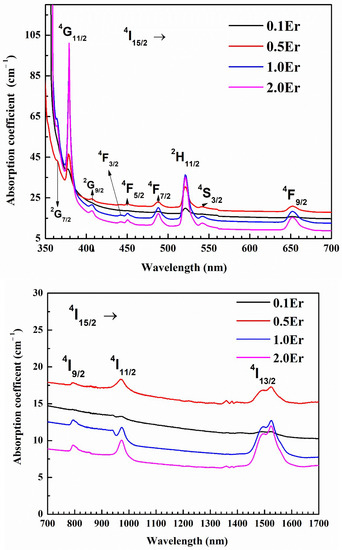
Figure 3.
Optical absorption spectra of UV-vis (350–700 nm) (upper) and NIR (700–1700 nm) (lower) of Er3+ singly activated ZBB glasses.
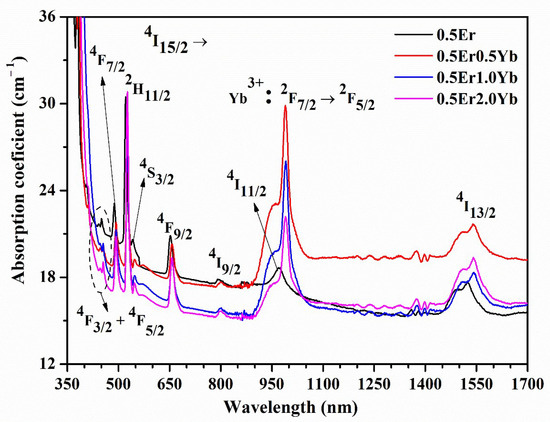
Figure 4.
Linear absorption spectral outcomes of Er3+/Yb3+ ions co-doped ZBB glasses from UV-vis to NIR (350–1700 nm) region.
Further, oscillator strengths, both fexp and fms of the Er3+ doped glasses were computed using the relations mentioned in the references [23,24,25] and are tabulated in Table 2. The Judd-Ofelt (JO) factors viz. Ω2, Ω4 and Ω6 were evaluated be referring to the procedure explained in references [26,27]. Both fexp and fcal, along with their root mean square deviations (σrms) are furnished in Table 2. It is already proved that the JO factors describe local ligand environments around the dopants (Er3+ ions), and the strength of covalency between the ligand bonds. Thus, information about the site symmetry of Er3+ ions can be determined from Ω2 and it is sensitive to HST, while Ω4 and Ω6 depend on the bulk property and viscosity of a host glass. The JO factors of singly Er-doped borate glasses are calculated and tabulated in Table 3. Among all, 0.5Er glass attain the higher values which suggest the strong covalency nature between Er-O. Further, an increase in doping of Er3+ into host glass reduced the strength of Ω2. This paramount shift is attributed to the decrease in order of symmetry around the Er3+ ions in in the studied glasses [22,23,24]. The JO parameters of the present borate glasses are comparable with SANSCEr10 [5], PKSAEr10 [22], fluorotellurite [23], ELB [24], TBA1 [25], TZN [28], BLK1.0Er [29], CaBaPEr20 [30], TBL [31] and lead phosphate [32] of Er3+ doped different glass materials.

Table 2.
Experimental (fexp) and calculated (fcal) oscillator strengths (10−6) of Er3+ loadedin ZBB glasses.

Table 3.
The comparison of Judd-Ofelt parameters Ωλ (λ = 2, 4 and 6 × 10−20 cm2) of Er3+ ions in different glass networks.
The NIR luminescence spectra of (0.1Er–2.0Er) doped zinc borate glasses are depicted in Figure 5. All samples emitted the broad NIR emission (1440–1680 nm) and a peak at 1529 nm (1529 nm due to electronic motion from 4I13/2 level to 4I15/2 level of Er3+. Thus, the NIR emission covering C and L bands of the telecommunication window thereby it can be utilized for optical amplifier applications.. Interestingly, the intensity of NIR emission enhanced with Er3+ doping into the glass, from 0.1 to 0.5 mol%, and beyond that intensity of the same band, was decreased. This type of decrement is caused because of agglomeration of Er3+ ions in the examined glass. Hence, Er3+ ion concentrations increase, resulting in the reduction of distance among the Er3+ ions and it causing the quenching process.
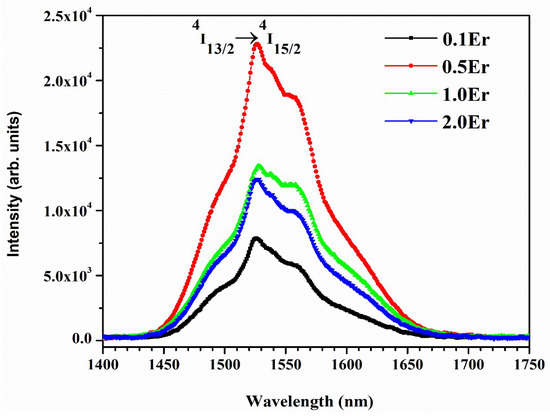
Figure 5.
Near-infrared emission spectra of Er3+ doped ZBB glasses.
Further, using the JO factors, the lasing potentials, such as emission maxima (λp), effective line width (Δλeff), stimulated emission cross-section (σemi), branching ratio (βR) and quantum efficiency (η) have been computed for the studied glasses by referring the procedure provided in the reference [23,24]. The resulted calculation shows values for σemi and AT of 0.5Er glass as superior among the 0.1 to 1Er glasses. Their values are 1.52, 1.14, 0.82, 0.80 (×10−21 cm2) and 281.1, 488.14, 357.76, 304.43 (s−1), respectively, corresponding to the 0.1Er, 0.5Er, 1.0Er, and 2.0Er glasses. The gain bandwidth (σemi × Δλeff) and optical gain for examined glasses are also evaluated and found to be decreased as the Er3+ concentration elevated to higher levels. Table 4 displays the radiative parameters of prepared glasses with other reported glasses [5,22,30,31,32]. The 0.5Er glasses σemi value is higher than that of reported different glass materials. Interestingly, the resulting other radiative parameters that use the emission spectra and JO parameters revealed that, the current glasses have substantial for 1530 nm broadband amplifiers and eye-safe efficient NIR lasers.

Table 4.
Radiative properties for 4I13/2 → 4I15/2 of Er3+ ions doped ZBB glasses along with other reported glasses.
PL spectra for single (0.5Er) and co-doped samples presented in Figure 6 for an excitation of 980 nm. The spectra consist of the representative band at 1550 nm due to electronic motion from 4I13/2 to 4I15/2 levels of Er3+. The amplitude of this peak improved with elevation of Yb3+ content in the composition. Interestingly, in the co-doped glasses, Er3+ ions emission intensity was enhanced with the effect of Yb3+ ions sensitization. This enhancement is due to the strong absorption cross-section of Yb3+ contrast to Er3+ at the pumped spectral region. The pumping wavelength, energy levels and transitions profile are displayed in the energy level diagram (Figure 7).
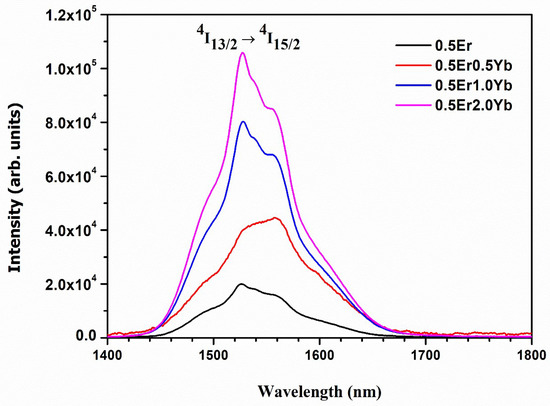
Figure 6.
Near-infrared emission 0.5 mol% Er3+ ions and Yb3+ ions co-doped ZBB glasses.
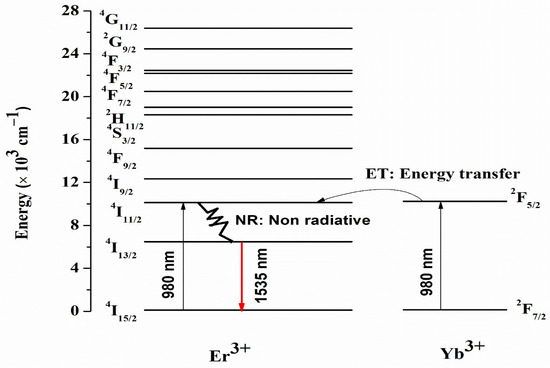
Figure 7.
Energy level scheme of Er3+ and Yb3+ ions in ZBB glasses.
Further, the absorption spectrum of 0.5Er glass was utilized to compute the absorption cross-section (σabs), whilst the stimulated emission cross-section (Mσemi) was computed by following the McCumber theory (MC). The McCumber hypothesis is always referred to for explaining the overlap between the σabs and Mσemi cross-sections. The factor of Mσemi influences the operation of a laser and all sets of these properties were realized with the assistance of the equations provided in the references [5,29].
From McCumber’s theory, the σabs and σabs profiles of 0.5Er and 0.5Er2.0Yb co-doped glasses are shown in Figure 8a,b, respectively.
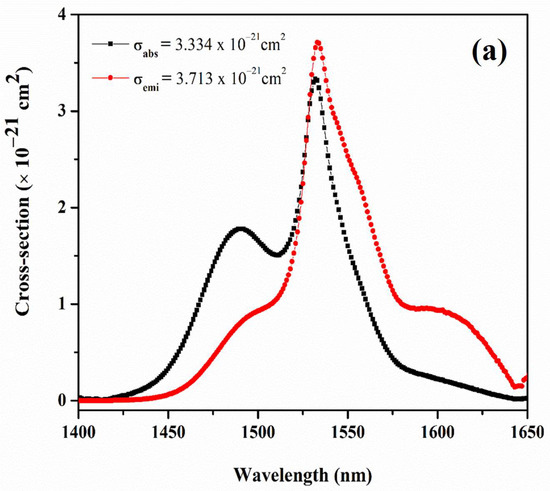
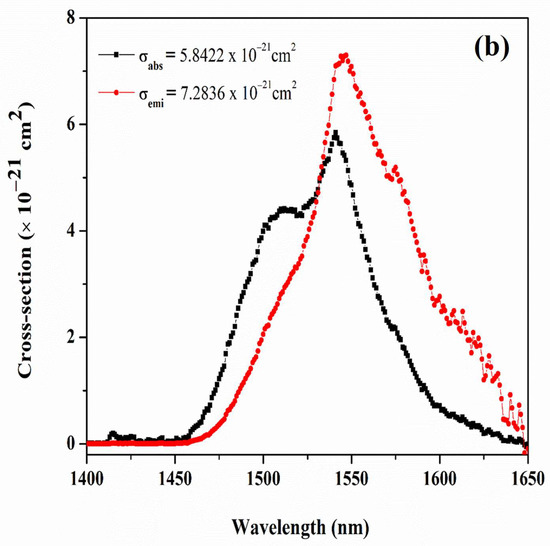
Figure 8.
Absorption and emission cross-section of 0.5Er doped (a) and 0.5Er2.0Yb co-doped (b) ZBB glasses.
From Figure 8, σabs and σemi magnitudes found to be 3.334 × 10−21 cm2 and 3.713 × 10−21 cm2 respectively at ~1530 nm whereas which for 0.5Er2.0Yb glass the magnitudes respectively found to be 5.842 × 10−21 cm2 and 7.283 × 10−21 cm2. The σemi value is found to be the maximum (7.283 × 10−21 cm2) for 0.5Er2.0Yb co-doped glasses and was enhanced ~2 times compared that of 0.5Er glass which is attributed to the resonant transfer of energy from Yb3+ to Er3+ ions.. These values are comparable with the other reported phosphate (0.5Er/12Yb: σabs = 6.15 × 10−21 cm2, σemi = 7.11 × 10−21 cm2) [33], and fluorophosphate glasses (3Er4Yb: σabs = 9.53 × 10−21 cm2, σemi = 9.86 × 10−21 cm2) [34].
Optical gain cross-section (G(λ)) has been used to ascertain the laser media performance. The G(λ) for ~1530 nm emission transition of 0.5Er glasses was determined by following equation [29]:
where factor P is the population rate. Figure 9 exhibits the spectra of the gain cross-section G(λ) of the 0.5Er and 0.5Er2.0Yb glasses. From the spectra, as the values of G(λ) increase, the gain band shifts toward the short wavelength side when N increases from 0 to 1. For ~1530 nm emission transition of Er3+:4I13/2–4I15/2, when N reaches 0.4, the G(λ) achieves a magnitude of 10−21 cm2. The maximum G(λ) is found to be 3.713 × 10−21 cm2 for 0.5Er and 7.2836 × 10−21 cm2 for 0.5Er2.0Yb glasses. G(λ) values of 0.5Er2.0Yb glasses increased 2 times compared to 0.5Er glasses and were also related to the phosphate glasses in the range of 7.11 × 10−21 cm2 [33], and are less than fluorophosphate glass (9.86 × 10−21 cm2) [34]. Hence, according to Figure 9, the synthesized co-doped glasses’ flat gain is in the range of 1460–1640 nm. This optimum performance describes the laser operation of the 1530 nm band at a lesser pump threshold, which is a prerequisite for laser operation [29]. Hence, the obtained result infers that Er3+ with Yb3+ co-doped bismuth zinc borate glasses are competing hosts as an optical medium for laser operation at 1530 nm [31].
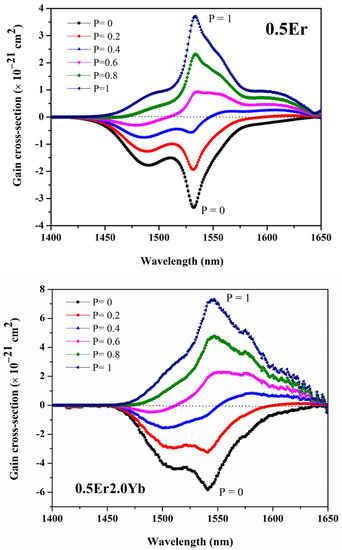
Figure 9.
Gain cross-section profile of 4I13/2 → 4I15/2 transition in the range of 1400–1650 nm of 0.5Er (upper) and 0.5Er2.0Yb (lower) glasses used in the current study.
The metastable lifetime of the Er3+ ions plays a significant role in the EDFA and solid-state laser gain medium applications. A higher metastable lifetime eases the population inversion condition of the doped glasses. However, the lifetime of the Er3+ can be decreased or increased with the change in the composition of glass, doping concentration of Er3+ and the transfer of resonant energy from trivalent ytterbium to trivalent erbium ions [35]. Thus, the decay profiles for 0.5Er and 0.5Er/(0.5, 1.0, and 2.0)Yb co-doped ZBB glasses for 4I13/2 → 4I15/2 transition under the excitation at 976 nm provided in Figure 10. The profiles of PL decay were well fitted to single-exponential, and the obtained lifetime values are 3.56 ms, 3.60 ms, 3.99 ms, and 4.03 ms for 0.5Er, 0.5Er0.5Yb, 0.5Er1.0Yb, and 0.5Er/2.0Yb glasses, respectively. The observed behavior analogous to other Er3+/Yb3+ glass matrices were as such: 65P2O5-13K2CO3-13BaCO3-8Al2O3-2ZnO [33]; 75NaH2PO4-20ZnO-5Li2CO3-Er2O3 [36]; 44P2O5+23PbO+17K2O+9Al2O3+6Na2O [37]. The closeness between the energy levels of 4F5/2 (Yb3+) to 5I11/2 (Er3+) ions [36] led to a high population inversion at the 5I11/2 level due to transfer of resonant energy from the Yb3+ to Er3+ ions when excited at 980 nm.
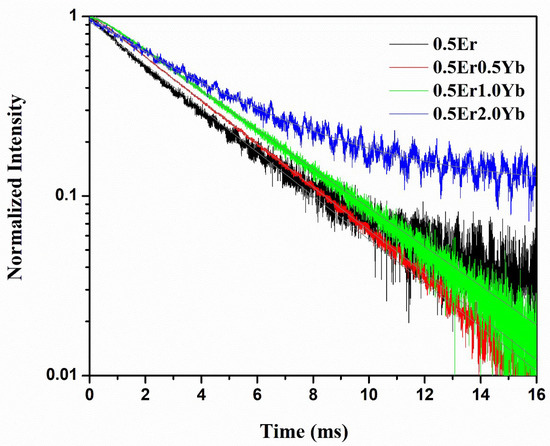
Figure 10.
Decay profiles of 4I13/2 → 4I15/2 transition of 0.5Er and Er3+/Yb3+co-doped ZBB glasses.
4. Conclusions
In this study, the absorption spectra of the glass were observed with 12 absorption lines, with an increase of intensity with respect to Er3+ doping from 0.1 to 2 mol%. The addition of Yb3+ ion into the glass network added an extra absorption transition at 980 nm was observed. The JO factors Ω2 = 9.15 × 10−20, Ω4 = 4.07 × 10−20, and Ω6 = 3.31 × 10−20 cm2, were the highest for 0.5 mol% Er3+ loaded glass; which infers the bond between Er3+ to O2− was covalent.. The NIR emission of the telecommunication window was highest in 0.5 mol% of Er3+ doped zinc bismuth borate glass. The obtained radiative transition probability (488.14 s−1), branching ratio (1) stimulated emission cross-section (11.41 × 10−21 cm2), radiative lifetime (3.2 ms), gain bandwidth (984.86 × 10−28 cm3) and an optical gain (39.48 × 10−25 cm2−s) of 0.5 mol% Er3+ loaded in borate glass suggest potential use for the construction of 1.53 µm optical amplifiers and efficient NIR lasers. Along with emission intensity, 2 mol% of Yb3+ co-doping enhanced the emission gain cross-section (7.283 × 10−21 cm2) of the glass by two times when compared to the 0.5 mol% Er3+ singly doped glass network. This increase in gain cross-section shifted the gain band for lower spectral side when P increased from 0 to 1 and for the Er3+: 4I13/2–4I15/2 emission, and when P reached 0.4, the gain cross-section achieved a magnitude of 7.283 × 10−21 cm2 in the 2 mol% of Yb3+ co-activated glass. The 0.5Er2Yb glass has a flat gain in the range of 1460–1640 nm and its behavior proved that the lower pump threshold is sufficient for laser operation within the 1530 nm band and optical window of telecommunication.
Author Contributions
V.H.: Conceptualization, Methodology, Data curation, Investigation, Writing—original draft; G.D.: Data curation, Writing—original draft; A.G.P.: Data curation, Formal analysis; S.B.K.: Data curation, Formal analysis; D.A.A.: Data curation, Writing—review & editing; A.H.A.: Data curation, Writing—review & editing; M.I.S.: Writing—review & editing; G.J.: Conceptualization, Methodology, Data curation, Writing—review & editing. All authors have read and agreed to the published version of the manuscript.
Funding
This research was funded by Princess Nourah bint Abdulrahman University Researchers Supporting Project (PNURSP2022R57), Princess Nourah bint Abdulrahman University, Riyadh, Saudi Arabia.
Institutional Review Board Statement
Not applicable.
Informed Consent Statement
Not applicable.
Data Availability Statement
All the data have been reported in the manuscript.
Acknowledgments
The authors express their gratitude to Princess Nourah bint Abdulrahman University Researchers Supporting Project (PNURSP2022R57), Princess Nourah bint Abdulrahman University, Riyadh, Saudi Arabia.
Conflicts of Interest
The authors declare no conflict of interest.
References
- Liu, X.; Zhang, M.; Guo, R.; Liu, X.; Pan, X.; Chen, K. Deng, W. Optical properties and luminescence of Er3+/Yb3+ co-doped La2O3–Nb2O5–Ga2O3 glasses prepared by aerodynamic levitation method. Opt. Mater. 2020, 109, 110288. [Google Scholar] [CrossRef]
- Chen, Y.; Huang, Y.; Huang, M.; Chen, R.; Luo, Z. Spectroscopic properties of Er3+ ions in bismuth borate glasses. Opt. Mater. 2004, 25, 271–278. [Google Scholar] [CrossRef]
- Pal, I.; Sanghi, S.; Agarwal, A.; Aggarwal, M.P. Spectroscopic and structural investigations of Er3+ doped zinc bismuth borate glasses. Mater. Chem. Phys. 2012, 133, 151–158. [Google Scholar] [CrossRef]
- Jose, A.; Gopi, S.; Krishnapriya, T.; Jose, T.A.; Joseph, C.; Unnikrishnan, N.V.; Biju, P.R. Spectroscopic investigations on 1.53 μm NIR emission of Er3+ doped multicomponent borosilicate glasses for telecommunication and lasing applications. Mater. Chem. Phys. 2021, 261, 124223. [Google Scholar] [CrossRef]
- Devarajulu, G.; Ravi, O.; Reddy, C.M.; Ahamed, S.Z.A.; Raju, B.D.P. Spectroscopic properties and upconversion studies of Er3+-doped SiO2-Al2O3-Na2CO3-SrF2-CaF2 oxyfluoride glasses for optical amplifier applications. J. Lumin. 2018, 194, 499–506. [Google Scholar] [CrossRef]
- Ravi, O.; Dhoble, S.J.; Ramesh, B.; Devarajulu, G.; Reddy, C.M.; Linganna, K.; Reddy, G.R.; Raju, B.D.P. NIR fluorescence spectroscopic investigations of Er3+-ions doped borate based tellurium calcium zinc niobium oxide glasses. J. Lumin. 2015, 164, 154–159. [Google Scholar] [CrossRef]
- Gao, G.; Wei, J.; Shen, Y.; Peng, M.; Wondraczek, L. Heavily Eu2O3-doped yttria-aluminoborate glasses for red photoconversion with a high quantum yield: Luminescence quenching and statistics of cluster formation. J. Mater. Chem. C 2014, 28, 8678–8682. [Google Scholar] [CrossRef] [Green Version]
- Bomfim, F.A.; Martinelli, J.R.; Kassab, L.R.P.; Wetter, N.U.; Neto, J.J. Effect of the ytterbium concentration on the upconversion luminescence of Yb3+/Er3+ co-doped PbO–GeO2–Ga2O3 glasses. Non-Cryst. Solids 2008, 354, 4755–4759. [Google Scholar] [CrossRef]
- Feng, L.; Wang, J.; Tang, Q.; Hu, H.; Liang, H.; Su, Q. Solids Optical properties of Er3+-singly doped and Er3+/Yb3+-codoped novel oxyfluoride glasses. J. Non-Cryst. 2006, 352, 2090–2095. [Google Scholar] [CrossRef]
- Qi, C.; Hu, L.; Dai, S.; Jiang, Y.; Liu, Z. Spectra and lasing properties of Er3+, Yb3+:phosphate glasses. Chin. Opt. Lett. 2003, 1, 37–40. [Google Scholar]
- Ji, Y.; Xiao, Y.; Huang, S.; Wang, W. Optical properties of Er3+ and Yb3+/Er3+-doped NaF-Na2SO4-Al(PO3)3 fluoro-sulfo-phosphate glasses. Am. Ceram. Soc. 2020, 103, 5664–5677. [Google Scholar] [CrossRef]
- Pisarski, W.A.; Grobelny, Ł.; Pisarska, J.; Lisiecki, R.; Ryba-Romanowski, W. Spectroscopic properties of Yb3+ and Er3+ ions in heavy metal glasses. J. Alloys Compd. 2011, 509, 8088–8092. [Google Scholar] [CrossRef]
- Shang, Z.; Ren, G.; Yang, Q.; Xu, C.; Liu, Y.; Zhang, Y.; Wu, Q. Spectroscopic properties of Er3+-doped and Er3+/Yb3+-codoped PbF2–MOx (M = Te, Ge, B) oxyfluoride glasses. J. Alloys Compd. 2008, 460, 539–543. [Google Scholar] [CrossRef]
- Deopa, N.; Rao, A.S.; Gupta, M.; Prakash, G.V. Spectroscopic investigations of Nd3+ doped Lithium Lead Alumino Borate glasses for 1.06 μm laser applications. Opt. Mater. 2018, 75, 127–134. [Google Scholar] [CrossRef]
- Hegde, V.; Wagh, A.; Hegde, H.; Vishwanath, C.S.D. Spectroscopic investigation on europium doped heavy metal borate glasses for red luminescent application. Appl. Phys. A 2017, 12, 1–13. [Google Scholar] [CrossRef]
- Jadach, R.; Zmojda, J.; Kochanowicz, M.; Miluski, P.; Pisarska, J.; Pisarski, W.A.; Sołtys, M.; Lesniak, M.; Sitarz, M.; Dorosz, D. Investigation of the aluminum oxide content on structural and optical properties of germanium glasses doped with RE ions. Spectrochi. Acta Part A Mol. Biomol. Spectrosc. 2018, 201, 143–152. [Google Scholar] [CrossRef]
- Dias, J.D.M.; Melo, G.H.A.; Lodi, T.A.; Carvalho, J.O.; Filho, P.F.F.; Barboza, M.J.; Steimacher, A.; Pedrochi, F. Thermal and structural properties of Nd2O3-doped calcium boroaluminate glasses. J. Rare Earths 2016, 34, 521–528. [Google Scholar] [CrossRef]
- Rani, S.; Sanghi, S.; Ahlawat, N.; Agarwal, A. Influence of Bi2O3 on thermal, structural and dielectric properties of lithium zinc bismuth borate glasses. J. Alloys Compd. 2014, 597, 110–118. [Google Scholar] [CrossRef]
- Doweidar, H.; Saddeek, Y.B. FTIR and ultrasonic investigations on modified bismuth borate glasses. J. Non-Cryst. Solids 2009, 355, 348–354. [Google Scholar] [CrossRef]
- Pascuta, P.; Pop, L.; Rada, S.; Bosca, M.; Culea, E. The local structure of bismuth borate glasses doped with europium ions evidenced by FT-IR spectroscopy. J. Mater. Sci. Mater. Electron. 2008, 19, 424–428. [Google Scholar] [CrossRef]
- Carnall, W.T.; Fields, P.R.; Rajnak, K. Electronic Energy Levels in the Trivalent Lanthanide Aquo Ions. I. Pr3+, Nd3+, Pm3+, Sm3+, Dy3+, Ho3+, Er3+, and Tm3+. J. Chem. Phys. 1968, 49, 4424–4442. [Google Scholar] [CrossRef]
- Linganna, K.; Rathaiah, M.; Vijaya, N.; Basavapoornima, C.; Jayasankar, C.K.; Ju, S.; Han, W.T.; Venkatramu, V. 1.53 µm luminescence properties of Er3+-doped K–Sr–Al phosphate glasses. Ceram. Int. 2015, 41, 5765–5771. [Google Scholar] [CrossRef]
- Burtan-Gwizdala, B.; Reben, M.; Cisowski, J.; Szpil, S.; Yousef, E.S.; Lisiecki, R.; Grelowska, I. Thermal and spectroscopic properties of Er3+-doped fluorotellurite glasses modified with TiO2 and BaO. Opt. Mater. 2020, 107, 109968. [Google Scholar] [CrossRef]
- Swetha, B.N.; Devarajulu, G.; Keshavamurthy, K.; Jagannath, G.; Deepa, H.R. Enhanced 1.53 µm emission of Er3+ in nano-Ag embedded sodium-boro-lanthanate glasses. J. Alloys Compd. 2021, 856, 158212. [Google Scholar] [CrossRef]
- Wu, L.; Zhou, Y.; Zhou, Z.; Cheng, P.; Huang, B.; Yang, F.; Li, J. Effect of silver nanoparticles on the 1.53 μm fluorescence in Er3+/Yb3+ codoped tellurite glasses. J. Opt. Mater. 2016, 57, 185–192. [Google Scholar] [CrossRef]
- Judd, B.R. Optical absorption intensities of rare-earth ions. Phys. Rev. 1962, 127, 750–761. [Google Scholar] [CrossRef]
- Ofelt, G.S. Intensities of crystal spectra of rare-earth ions. J. Chem. Phys. 1962, 37, 511–520. [Google Scholar] [CrossRef]
- Li, Y.; Dou, B.; Xiao, Z.; Li, B.; Huang, F.; Li, Y.; Xu, S. Visible-infrared luminescence of Er3+-doped fluorotellurite glasses. Opt. Mater. 2020, 105, 109900. [Google Scholar] [CrossRef]
- Mariyappan, M.; Arunkumar, S.; Marimuthu, K. Judd-Ofelt analysis and NIR luminescence investigations on Er3+ ions doped B2O3–Bi2O3–Li2O–K2O glasses for photonic applications. Phys. B Condens. Matter. 2019, 572, 27–35. [Google Scholar] [CrossRef]
- Luewarasirikul, N.; Chanthima, N.; Tariwong, Y.; Kaewkhao, J. Erbium-doped calcium barium phosphate glasses for 1.54 µm broadband optical amplifier. Mater. Today Proc. 2018, 5, 14009–14016. [Google Scholar] [CrossRef]
- Zhang, Y.; Xiao, Z.; Lei, H.; Zeng, L.; Tang, J. Er3+/Yb3+ co-doped tellurite glasses for optical fiber thermometry upon UV and NIR excitations. J. Lumin. 2019, 212, 61–68. [Google Scholar] [CrossRef]
- Basavapoornima, C.; Linganna, K.; Kesavulu, C.R.; Ju, S.; Kim, B.H.; Han, W.T.; Jayasankar, C.K. Spectroscopic and pump power dependent upconversion studies of Er3+-doped lead phosphate glasses for photonic applications. J. Alloys Compd. 2017, 699, 959–968. [Google Scholar] [CrossRef]
- Zhao, Z.; Zhang, B.; Gong, Y.; Ren, Y.; Huo, M.; Wang, Y. Concentration effect of Yb3+ ions on the spectroscopic properties of high-concentration Er3+/Yb3+ co-doped phosphate glasses. J. Mol. Struct. 2020, 1216, 128322. [Google Scholar] [CrossRef]
- Linganna, K.; Agawane, G.L.; In, J.H.; Park, J.; Choi, J.H. Spectroscopic properties of Er3+/Yb3+ co-doped fluorophosphate glasses for NIR luminescence and optical temperature sensor applications. J. Ind. Eng. Chem. 2018, 67, 236–243. [Google Scholar] [CrossRef]
- Linganna, K.; Narro-García, R.; Manasa, P.; Desirena, H.; de la Rosa, E.; Jayasankar, C.K. Effect of BaF2 addition on luminescence properties of Er3+/Yb3+ co-doped phosphate glasses. J. Rare Earths 2018, 36, 58–63. [Google Scholar] [CrossRef]
- Langar, A.; Bouzidi, C.; Elhouichet, H.; Férid, M. Er–Yb codoped phosphate glasses with improved gain characteristics for an efficient 1.55 µm broadband optical amplifiers. J. Lumin. 2014, 148, 249–255. [Google Scholar] [CrossRef]
- Basavapoornima, C.; Maheswari, T.; Depuru, S.R.; Jayasankar, C.K. Sensitizing effect of Yb3+ ions on photoluminescence properties of Er3+ ions in lead phosphate glasses: Optical fiber amplifiers. Opt. Mater. 2018, 86, 256–269. [Google Scholar] [CrossRef]
Publisher’s Note: MDPI stays neutral with regard to jurisdictional claims in published maps and institutional affiliations. |
© 2022 by the authors. Licensee MDPI, Basel, Switzerland. This article is an open access article distributed under the terms and conditions of the Creative Commons Attribution (CC BY) license (https://creativecommons.org/licenses/by/4.0/).